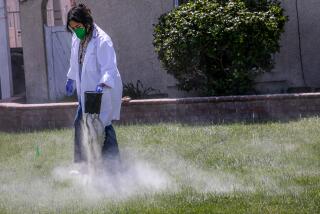Microbes Clean Soil Polluted With Selenium
SAN FRANCISCO — Microbes are removing selenium from contaminated soil on a test plot at the polluted Kesterson Reservoir, a finding that may lead to a full-scale cleanup of the area.
Preliminary studies show that the microbes can remove at least two-thirds of the selenium from the polluted earth, UC Riverside agronomist William Frankenberger is scheduled to tell a meeting of the American Chemical Society here today. The remaining selenium is so tightly bound to the soil that it poses no risk to wildlife, Frankenberger said.
The process could be used to restore Kesterson Reservoir, which is closed because of the selenium problem, at a cost far lower than that of other options, Frankenberger said. Perhaps more important, it could be used to remove excess selenium, a non-metallic chemical element, from soils on the western side of the San Joaquin Valley that have been contaminated by agricultural use.
Frankenberger’s process is “very promising, which is why we have been supporting it for several years,” said Mike Delamore of the U.S. Bureau of Reclamation, which is in charge of cleaning up Kesterson. But it is too soon to determine whether its use at Kesterson should be expanded, he added.
“It may take several months to several years to dissipate all the selenium” at Kesterson if this approach is adopted, Frankenberger said. “But its attractiveness is that it is a permanent removal rather than concentrating the selenium somewhere else.”
Kesterson Reservoir comprises 1,280 acres of irrigation evaporation ponds in the middle of the Kesterson National Wildlife Refuge in Merced County near Fresno. Its marshlands were once a major stopping point along the Pacific Flyway, the wetlands route followed every year by hundreds of thousands of migrating shore birds and waterfowl.
In 1983, however, biologists studying the reservoir found grossly deformed bird embryos missing wings, legs and toes. Beaks of black-necked stilts curved grotesquely; brains protruded through holes where eyes should have been. They also found hundreds of dead adult birds and thousands of unhatched eggs.
The problem was traced to high levels of selenium in the reservoir. The selenium, used in agricultural chemicals, washed off farmlands and was carried into the reservoir by the San Luis drain.
Although low levels of selenium are essential to life, high levels are toxic. The U.S. Environmental Protection Agency has set maximum safe levels of selenium at 10 parts per billion in water and 4 p.p.b. in soil. At Kesterson, the levels were as high as 3,000 p.p.b. in water and 250 p.p.b. in soil.
In 1985, Kesterson Reservoir was closed. In 1989, the Bureau of Reclamation spent $23 million to bury part of the contaminated soil under uncontaminated soil. But large areas still contain abnormally high levels of selenium and critics and environmentalists fear that water leaching through the soil will recontaminate the fresh soil.
In a process called volatilization, the soil at Kesterson contains at least five species of fungi that convert selenium into a gas called dimethylselenide. The gas is dispersed by winds. But the fungi normally work too slowly to keep up with the influx of selenium into the soil.
Beginning in 1985, Frankenberger and his colleagues began working with the fungi to find ways to speed up their activity. Eventually, he found that volatilization could be greatly speeded up by tilling the soil, adding nutrients for the fungi (such as cattle manure, proteins from milk casein and pectin from citrus peels) and adding low concentrations of activators such as zinc and cobalt. The rate of volatilization was speeded up 200-fold.
In 1988, he applied the technique to a one-third acre test plot at Kesterson. He found that the fungi removed about 28% of the selenium per year over a little more than two years until about two-thirds of it was gone. The rest was bound so tightly to the soil that the microbes could not get it.
In 1990, Frankenberger began work on a larger, two-acre plot. Although analyses of the soil have not been completed, “we are detecting a considerable amount of gas being released,” he said in an interview.
Studies by other researchers have shown that selenium does not accumulate in human bodies, which also excrete it. But selenium does adversely affect birds, which “don’t have this mechanism for detoxifying it,” Frankenberger said.
He emphasized that the dimethylselenide gas does not produce a risk. Toxicology studies with rats have shown that they exhale most of the dimethylselenide that they inhale and that the rest is excreted and does not accumulate in their bodies.
The gas becomes “so dispersed it could actually have beneficial effects,” he said. “On the east side of the valley, they have severe deficiencies of selenium”--so severe that ranchers have to inject selenium pellets into cattle to prevent them from developing a degenerative disease called “white muscle.” “We could be solving two problems simultaneously,” he said.
More to Read
Sign up for Essential California
The most important California stories and recommendations in your inbox every morning.
You may occasionally receive promotional content from the Los Angeles Times.










